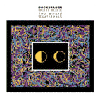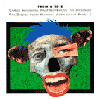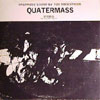Compositions » Quatermass
Quatermass was intended, from the start, to be a very dense, massive, even threatening, work of high levels and high energy. It was my antidote to the preceding Water Music - a work of small details, delicate textures, and some playfulness. The title was chosen because the word sounded right for the work. It happened to be the name of Professor Bernard Quatermass, star character of a 1950s BBC-TV science fiction serial and two B films (The Creeping Unknown [1956] and Enemy from Space [1957]); at the time, I hadn’t seen them.
The basic sound source in Quatermass is a balloon (By stretching the neck of an inflated balloon, you can change the pitch of the escaping air, it becomes a double-reed instrument). As with all my pieces, work began with collecting what I call “cells” (Schaeffer called them “soundobjects”): hours and hours of quarter inch tape recordings of whatever interested me, the original sound transmuted with (what are now called) “classical” tape-studio techniques. By the time I did “Quatermass”, I guess I had a library of around 300,000 feet of tape (125 hours at 15ips.). From this mass, I would select cells that seemed like they might work together into a piece, and then turn them into stereo (with more classical techniques of tape-delay and tape-echo between channels, panning, reverberation, and placement). For “Quatermass”, I had, for the first time, use of a three-track recorder (the third track filled the center “hole” in early stereo recording), which allowed me to do more complex tape-echo rhythms than before (heard in “Tango” and “Flight”) and thicker sound-masses - the “wall” of sound I wanted for the piece.
To mix all this together, I had a six-channel mixer (tubes), one mono, one 2-track, and the 3-track machines as feeds into a quarter-inch, 2-track recorder. That was it (the most elaborate setup I ever had) - no “layering,” just one-pass mixing to the master tape. All this was tube equipment with no noise reduction (I reduced tape hiss by using, for the first time, a free box of experimental low-noise tape from 3M and forcing the oxide with high levels of recording).
The final (and longest) stage was to edit the mixes into the five movements (this was where the Moons were born). I’d guess the forty-six minutes of Quatermass were wrenched out of probably a dozen hours of mixed tape.
“Song and Lament” does indeed have a song and lament. “Tango”, although it doesn’t start like a tango, becomes something like a tango, and “Parade” is sort of a pompous, John Philip Sousa crashing about. “Flight” continues the source ideas of “Tango” on a darker level, and the final part, “Second Song,” is a long working-out of the energies, and an attempt at balancing the weights of the first four parts; it uses the same sound materials, with the addition of a second song figure, a kind of inversion of the first. The gong that ushered in the first song ushers out the second.
Song and Lament A gong, several balloons, a toy cat-cry (or maybe it was a slowed cow-cry), two (unstable) test generators
Tango The generators, the balloons, lots of tape-echo to create the rhythm
Parade A cymbal, rolls of adhesive tape in different widths, elevator motors and white noise (taken from FM radio)
Flight A hollow pipe, a vacuum cleaner hose, a bamboo flute, the balloons.
Second Song Almost all the above, plus chimes (Two Moons use these same materials).
Quatermass act 3: Parade
Releases

Quatermass (STARKLAND, 1992)
ST-201
Water Music, Quatermass, and Two Moons of Quatermass.

From A to Z (STARKLAND, 1993)
ST-203
Excerpt from Luna Park, Part Three (from Apocalypse), Tango (from Quatermass), plus works by Paul Dresher, Joseph Kasinskas, Joseph Lukasik, Pamela Z, Barbara Imhoff, Charles Amirkhanian, and Phillip Kent Bimstein.

Organised Sound by Tod Dockstader (OWL Records, 1966)
ORLP-8
Quatermass: Song and Lament, Tango, Parade, Flight, Second Song